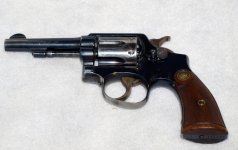ok i got a few pics uploaded to original post. thanks for the help. what would something like this be worth?
First, the grips/stocks alone are worth a pretty penny. A specialist collector will tell you more. Stay tuned... Those came off of a gun of this type made between about 1910-1920, or until the supply was exhausted. The brass (?) medallion at the top is the distinguishing feature. Your gun probably had smooth walnut grips. Peacetime grips were checkered, but had a silver medallion (not gold) at the top at that time.
Next, your gun is missing the lanyard swivel and ring. That's why it has a hole in the butt. Replacement parts are fairly easy to find, if you want to restore it. I would. Collectors will insist on this.
I cannot be sure from the photos if this gun has been reblued. The finish looks pretty bright for a Victory Model. They normally have a dull gray Midnight Black (looks like Parkerizing) finish with some tool marks that weren't polished off right, due to the rush of wartime production. However, some are better made than others. The lettering on your gun looks sharp and not refinished. There are a couple of brown spots on the cylinder that may be rust?
You may be interested to know that this is the sort of revolver that JFK had on his lanyard while he swam around in the Pacific while trying to rescue his crew when a Jap destroyer cut his PT boat in two. It saw very heavy issue to the Navy, especially to air crews and to USMC and other units. The Maritime Commission and the USCG aso used a lot of them. OSS had some and relatively few were used by the Army. Many went to plant guards and civilian cops. SOME of the Navy guns are marked as such.
The G.H.D. initials on the topstrap mean that the gun was inspected by Col. Guy H. Drewry (sp?) or one of his inspectors prior to acceptance by the miiitary.
Until recently, the Victory Model was regarded as just a rougher version of the Military and Police revolver, called Model 10 after 1957, when the company assigned model numbers. They were cheaper, because of the surplus gun factor and the rougher finish. Now, many are collecting them as WWII and US Martial items and the price has gone up.
If you are out to get the best price, add the lanyard ring and the original type smooth stocks and IF the finish is original, ask $400 and see if anyone bites. Some will pay more, many less. Keep in mind that a collector will pay more than just someone wanting a .38 for real world use. They can buy a commercial M&P for $250-350 and get a better finish and later production suited for use with Plus P ammo, if needed. Personally, I'd pay a little more (if needed; prices overlap) and get a stainless Model 64, made after about 1970. There are many police trade-ins of those.
You can probably sell those grips alone for over a hundred dollars, maybe three times that to someone who really wants them for an older gun.
I hope that you keep the gun as-is and hand it down in the family as an heirloom.
Oh: on those older guns, you may indeed find the serial number in pencil on the inside of the right grip panel. BUT, this will NOT be the serial number of your later gun! However, you can post here and see if anyone owns a gun with that number, and he may buy the grips. Strange things like that happen.



